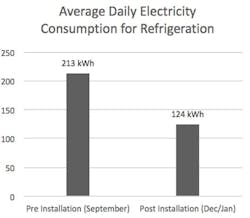In energy management classes I have taught all over the world during the past year, most participants report that they are implementing some type of LED lighting retrofit. From Bangladesh and Singapore to the U.S., LEDs are replacing most types of lights whether they are fluorescent, high-intensity discharge or standard A lamps. This article shares guidelines that will help you avoid common mistakes and capitalize on lessons learned.
#1: Test Sample Fixtures
LEDs have a higher efficacy (lumens/watt) than traditional lighting systems, so you may not need to match lumens to get the same lighting level within a room. In addition, LEDs are generally pointed down, giving them better targeting, i.e., increasing the coefficient of utilization. Therefore, more of the lumens exiting the lamp will actually reach the target.
This improved targeting of LEDs is great for efficiency/effectiveness, but a common complaint is glare. This is especially true when you are retrofitting existing fixtures that were designed for non-LED bulbs. Make sure you get some LED samples and test them in the actual fixtures where you plan to install them. This is the only way you can experience/see/feel the impact. Ask the occupants what they think of the samples. Also, don’t test only one fixture. Instead, test five or six fixtures in an area in order to judge the overlap effect and brightness.
Another reason to do adequate testing in the actual space is that some marketing materials can be misleading. Marketing photos may show the lighting from an angle that is not the same as the angle from which occupants will view it. As a result, the photos may hide glare, especially if they were taken when daylight was present.
#2: Buy Quality Products
In recent years, LEDs have improved significantly and I don’t hear as much about premature failures due to inadequate heat sinks or heat accumulation within fixtures. However, I still stand by my rules:
- Do not buy any LED that does not have at least a 5-year, non-prorated guarantee.
- Buy from a company/product line that is likely to be in existence 5 years from now.
You should also look for the right credentials when buying LEDs. You need to be sure that the lights are safe and have passed some standardized performance tests. Popular tests for safety are indicated by UL (Underwriters Laboratories) and ETL (Environmental Testing Laboratories) labels. You may need these marks for insurance companies to cover the loss in case of a fire. For performance tests, look for the DLC (DesignLights Consortium) label or LM 80, which are tests to ensure that the lamps perform well over time. LM80 indicates the number of hours at which 20% of the initial lumens have depreciated (leaving 80% of the lumens). The picture below shows the lumen depreciation curve for a particular lamp.
#3: Understand Utility Rebates
Before you specify or buy your lights, be sure they meet the criteria for utility rebates, which are free money. Most utilities will not approve a rebate unless the lighting systems meet certain qualifications. When completing your rebate application, also consider how your retrofit is described (e.g., “lamp replacement” or “retrofit kit”). The description can influence the size of your rebate. I have found that my clients received larger rebates when I labeled them as a “custom retrofit.” A custom retrofit application is usually a rebate based on the number of kW reduced; the utility assigns a dollar value to that reduction.
Note that as new models of LEDs become available, many of those need to be re-tested to qualify for their credentials as well as their rebates. For example, the 18-watt LED tubes that I have written about previously now have a 12-watt version and some models have surpassed 150 lumens/watt. However, to get the rebates, I had to wait until those new models had passed the tests and been listed under the rebate programs.
#4: Budgeting for Replacements in 10 years
LEDs do save energy and maintenance costs, but don’t forget to budget for their replacement when the lamps do fail. For many facilities that operate one shift, failure occurs around the 10-year mark. Although the overall savings from LEDs are usually net positive, when you do have to replace them, it will cost more than the traditional $2 fluorescent tubes!
In addition, due to the rapid pace of technology advancements, it is highly likely that the LEDs you are installing now will be obsolete and unavailable in 10 years. You may need to start over with a different lighting technology and a whole new project.
I hope these tips will help you avoid some mistakes that I have made. If you need a refresher on basic lighting principles (efficacy, CRI, CCT, etc.), you can find a free webinar on this topic here.
---------------------------------------------------------
